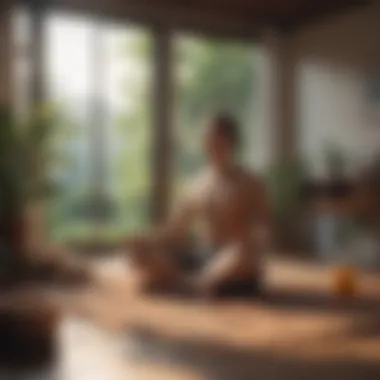How to Relax the Mind: A Comprehensive Guide


Intro
In our fast-paced modern society, the issue of stress and anxiety is omnipresent. People of all ages encounter daily pressures that can make mental relaxation feel like a distant dream. However, finding ways to relax the mind is not only essential but also entirely achievable with the right techniques. Incorporating mindful practices into one’s daily routine can lead to significant improvements in mental clarity and emotional stability.
This guide will explore different methods for calming the mind, delving into various relaxation techniques such as guided meditation and mindfulness practices. Each method is designed to cater to individuals from various backgrounds, whether they are busy professionals looking for quick stress relief or novices seeking deeper understanding of relaxation principles.
As we uncover the different aspects of relaxing the mind, we will emphasize building a personalized strategy that fits into one's lifestyle. A deliberate approach to integrating relaxation practices can yield profound benefits, fostering a sense of tranquility amidst the chaos of daily life.
Benefits of Guided Meditation
Guided meditation has emerged as a powerful tool for those seeking mental peace. This practice offers specific benefits that contribute to a more relaxed state of mind.
- Enhancing Mindfulness
Through guided meditation, individuals can cultivate a heightened sense of awareness. This process involves focusing on the present moment, allowing thoughts to come and go without attachment. Mindfulness encourages a more profound connection to oneself and the surrounding environment, diminishing the overwhelming effects of anxiety. - Reducing Anxiety
Engaging in guided sessions can help lessen feelings of anxiety. By promoting relaxation and encouraging deep breathing, guided meditation calms the nervous system. This focus on breathing leads to a reduction in heart rate and helps lower overall anxiety levels.
"Mindfulness is the aware, balanced acceptance of the present experience. It isn’t more complicated than that." - Nhat Hanh
Types of Guided Meditations
While there are various types of guided meditations, two popular categories stand out: morning meditations and evening relaxations.
- Morning Meditations
Morning sessions focus on setting a positive tone for the day. They often include intentions and affirmations, enhancing focus and motivation. These meditations can be brief, making them easy to integrate into a busy schedule. - Evening Relaxation
Evening guided meditations aim to unwind the mind and body after a long day. These sessions often incorporate calming visuals and soothing narratives. They help to release tension, ensuring a restful night’s sleep.
Understanding the Concept of Relaxation
Relaxation is more than just a state of being away from stress. It embodies a critical attribute for mental and emotional wellness. In today's world, where demands are constantly increasing, understanding relaxation becomes essential. This section explores mental relaxation, its importance, and how it can impact our mental health.
Defining Mental Relaxation
Mental relaxation refers to the process of reducing mental tension. It involves calming the mind and creating a tranquil state, allowing for clearer thoughts and deeper focus. Mental relaxation can include a variety of activities, such as focused breathing, meditation, or even aesthetic practices like listening to soothing music. The goal is to lower your body's stress response, which is often triggered by daily challenges and responsibilities.
It's important to understand that mental relaxation is not synonymous with sleep. Rather, it is a conscious practice of turning off the noise of daily life. By embracing these calming strategies, individuals can cultivate a serene internal environment, promoting better decision-making and emotional fortitude.
The Importance of Relaxation for Mental Health
The importance of relaxation for mental health cannot be understated. Stress and anxiety have become prevalent features in contemporary society. Studies indicate that prolonged stress can lead to severe mental health issues, including depression and chronic anxiety disorders. Thus, regular relaxation is not merely a luxury; it is a necessity.
Here are several reasons why relaxation practices contribute positively to mental health:
- Stress Reduction: Engaging in relaxation techniques leads to a reduction in cortisol levels, the stress hormone. Lower cortisol levels correlate with feelings of calmness and control.
- Emotional Balance: Regular relaxation fosters emotional regulation. It becomes easier to manage feelings and cope with unforeseen challenges when the mind is calm.
- Enhanced Focus: A relaxed mind is better at concentrating. This heightened focus can improve productivity, critical thinking, and creativity.
- Reduced Physical Symptoms: Stress harms the body, leading to headaches, fatigue, and muscle pain. By prioritizing relaxation, one can alleviate these physical manifestations.
"Relaxation is not an escape; it is a liberation from mental chaos."
Identifying Stress Triggers
Understanding the factors that elicit stress is a foundation for effective relaxation. Identifying stress triggers helps you become aware of external and internal stimuli that lead to feelings of anxiety and overwhelm. This knowledge is key in managing stress and improving mental wellbeing. By recognizing these triggers, you can take steps to mitigate their effects, thereby fostering a more relaxed state of mind.
Common Stressors in Daily Life
Daily life presents various stressors that can accumulate over time. Some common examples include:
- Work Pressure: Tight deadlines, high expectations, and demanding tasks can create a significant amount of stress for individuals.
- Relationships: Conflicts with family, friends, or work colleagues can be stress-inducing, often resulting in emotional turmoil.
- Financial Problems: Concerns about expenses, savings, or job security can weigh heavily on one's mind.
- Health Issues: Personal or loved ones' health problems can increase worry and anxiety, influencing mental state greatly.
Understanding these stressors is the first step toward addressing them. By being aware of what causes your stress, you can develop tailored strategies to manage each situation better.
Recognizing Personal Stress Responses
People react to stress in different ways. Recognizing your unique stress response is crucial for personal growth and mental health management. Common responses to stress include:


- Physical Signs: These may include headaches, muscle tension, or fatigue. Notice when your body reacts to situations that provoke stress.
- Emotional Changes: Feelings of irritability, sadness, or frustration often accompany stress. Acknowledging these emotions can assist in understanding your mental state.
- Behavioral Shifts: Changes in sleeping patterns, increased substance use, or withdrawing from social interactions may signal stress.
Once you can identify how stress presents itself in your life, you can take proactive steps to reduce its impact. This may involve implementing specific relaxation techniques or adjusting lifestyle habits.
"Awareness is the first step toward change. Understanding your stress triggers and responses can transform how you approach relaxation."
Identifying stress triggers is not just beneficial; it is essential. With this insight, you can integrate effective relaxation methods into your daily routine, fostering a more serene mindset and enhancing overall mental health.
Practical Relaxation Techniques
Relaxation techniques are essential in promoting mental serenity and mitigating stress. These practices equip individuals with skills to manage their emotional responses in challenging situations. They also aid in enhancing mental clarity and overall well-being. In today's fast-paced world, incorporating practical relaxation techniques is vital to maintain a healthier mindset and to foster resilience against daily stresses.
Mindfulness Practices
Understanding Mindfulness
Mindfulness is the practice of being fully present and engaged in the moment. This principle encourages attention to current experiences without judgment. One key characteristic of mindfulness is its simplicity. It does not require any special tools or settings, making it an accessible choice for anyone. Understanding mindfulness cultivates awareness of thoughts and feelings, promoting a calm mind.
A unique feature of mindfulness is its adaptability. It can be practiced anywhere—at home, work, or even in transit. This flexible nature allows fori seamless integration into daily life, helping individuals respond to stressors effectively. However, some may find it challenging to stay present, especially with distractions surrounding them.
Simple Mindfulness Exercises
Simple mindfulness exercises can provide effective relief from stress. These exercises often involve focusing on the breath or observing the environment. The key characteristic of such exercises is their ease of implementation. Individuals can participate for a few minutes or longer, depending on their schedule. This flexibility benefits busy individuals who seek quick moments of calm amidst their hectic routines.
The unique advantage of simple mindfulness exercises is their immediate impact. Even short sessions can lead to noticeable reductions in anxiety. However, beginners might struggle to maintain focus, which could hinder their initial experiences with mindfulness practices.
Meditation Approaches
Guided Meditation
Guided meditation involves listening to a narrator or instructor who leads the meditation process. This approach provides structure, making it easier for beginners to engage. One key characteristic is its accessibility, as many apps and online resources offer guided meditations tailored to various needs.
The unique feature of guided meditation is the supportive environment it creates. It alleviates common obstacles, such as distraction and uncertainty about what to do. Nevertheless, some individuals may prefer self-guided meditation, which can provide a sense of autonomy but may take time to master.
Transcendental Meditation
Transcendental Meditation requires practicing a specific technique for 20 minutes twice per day. This structured approach promotes relaxation and stress reduction. Its key characteristic is a focus on a specific mantra, aiding concentration and calmness.
A unique feature of Transcendental Meditation is its emphasis on regularity; it promotes consistency in practice. Long-term practitioners may experience significant improvements in overall mental health. However, access to training or classes may present a barrier for some individuals.
Breathing Techniques
Deep Breathing Exercises
Deep breathing exercises aim to cultivate a sense of relaxation through controlled breath. A significant aspect of deep breathing is its immediate effectiveness in reducing anxiety symptoms. These exercises are beneficial because they can be practiced anywhere, with minimal time commitment.
The unique feature of deep breathing techniques is their ability to activate the body's parasympathetic nervous system. This activation helps restore balance and promotes feelings of calm. However, some individuals may find it difficult to focus solely on their breath, which can affect the efficacy of the practice.
The 4-7-8 Breathing Technique
The 4-7-8 breathing technique combines intervals of breath to help regulate heart rate and promote relaxation. The structured pattern involves inhaling for four seconds, holding for seven, and exhaling for eight seconds. This technique's key characteristic is its simplicity and the significant calming effect it provides.
The unique aspect of this breathing method is its prescribed rhythm, which naturally encourages a reduction in stress levels. Many individuals find this practice effective in moments of heightened anxiety. However, newcomers may feel uncomfortable initially, and it could take some time to become accustomed to the rhythm.
Progressive Muscle Relaxation
Progressive muscle relaxation (PMR) focuses on tensing and then relaxing different muscle groups. This technique helps individuals become more aware of physical tension and promotes overall relaxation. One key aspect of PMR is its systematic approach, which guides users through different muscle groups, ensuring a comprehensive practice.
The unique benefit of PMR is its ability to connect physical relaxation with mental clarity. As individuals learn to release tension, they often experience a corresponding calming effect on their minds. However, some may need time to learn how to effectively tense and relax their muscles.


Creating a Relaxing Environment
Creating a relaxing environment is essential for mental relaxation. The surroundings we inhabit can significantly impact our state of mind. A well-arranged space has the potential to provide serenity, comfort, and warmth. This section explores critical elements that contribute to an atmosphere conducive to relaxation.
The Role of Physical Space
Physical space can influence how we feel and think. Decluttered areas often promote a sense of calm, while chaotic environments can induce stress. When arranging your space for relaxation, here are some key considerations:
- Decluttering: Start by removing unnecessary items. A tidy space helps reduce distractions, allowing for peaceful thoughts.
- Comfortable Furniture: Ensure that your seating is supportive and inviting. Sofas, chairs, or cushions contribute to creating a welcoming environment.
- Lighting: Soft and adjustable lighting can enhance relaxation. Try natural light through windows or incorporate warm-colored lamps. Avoid harsh fluorescent lights, as they can be uninviting.
- Aromatherapy: Scents trigger emotional responses. Consider using essential oils or scented candles for a calming effect. Lavender and chamomile are popular choices.
- Personal Touches: Incorporating personal items like photographs or mementos can make a space feel more secure and uniquely yours.
Achieving a harmonious physical space can indeed promote a more relaxed mental state.
Incorporating Nature into Your Space
Incorporating elements of nature can greatly enhance relaxation within your environment. Nature provides a grounding effect. Here are ways to bring nature into your space:
- Indoor Plants: Surrounding yourself with greenery can improve air quality and boost mood. Plants like snake plants or peace lilies require minimal effort and thrive indoors.
- Natural Light: Open your curtains to allow sunlight in. Exposure to natural light helps regulate circadian rhythms, promoting better sleep and relaxation.
- Nature Sounds: The sounds of water flow or nature can create a peaceful backdrop. Consider using calming soundtracks for relaxation or meditation.
- Natural Materials: Utilize wood, stone, or other natural materials in your home decor. They foster a connection with the earth and can enhance feelings of safety and calm.
- Outdoor Spaces: If possible, create an outdoor retreat. Balconies, porches, or gardens can serve as peaceful escapes.
"Nature does not hurry, yet everything is accomplished." - Lao Tzu
Incorporating nature not only beautifies the space but also provides substantial psychological benefits. A setting imbued with natural elements invites tranquility and fosters a sense of wellness.
Overall, developing a relaxing environment within your living or working space is both beneficial and achievable. Simple, intentional changes can encourage a mindset of calm and focus.
Incorporating Relaxation into Daily Life
Incorporating relaxation into daily life is essential for mental well-being. In our fast-paced world, stress becomes a constant companion. When individuals prioritize relaxation, they create a foundation for improved emotional resilience and clarity of thought. Regularly implementing relaxation strategies can lead to a heightened state of mindfulness. This practice not only combats stress but also nurtures creativity and productivity. Integrating relaxation appropriately requires understanding one's individual schedule and needs. This awareness allows the effective adjustment of habits that contribute positively to one’s mental health.
Establishing a Daily Routine
Creating a daily routine that includes relaxation moments provides structure and predictability. One effective strategy is to schedule specific times for relaxation practices. This can include dedicated time for mindfulness exercises, meditation, or simply quiet reading. Establishing a routine can enhance the sense of ownership over one's time and decisions. Additionally, a routine can help signal to the brain when it is time to wind down, effectively training the mind to recognize when relaxation is needed.
Techniques for Busy Individuals
For busy individuals, finding time to relax may seem daunting. However, several strategies can effectively facilitate relaxation without demanding extensive time commitments.
Effective Time Management
Effective time management plays a significant role in fitting relaxation into a busy schedule. It involves identifying tasks, setting priorities, and creating timelines that accommodate stress-reducing practices. By employing techniques such as the Pomodoro method, one can break tasks into intervals, allowing for scheduled breaks. The benefit of effective time management is that it not only increases productivity but also enables periods of rest, resulting in improved focus and reduced anxiety. Individuals can achieve a balanced approach that prioritizes both work and relaxation activities.
Short Relaxation Breaks
Short relaxation breaks are critical for maintaining mental health throughout the day. These breaks can be as brief as five minutes, during which one may engage in deep breathing, stretching, or mindfulness exercises. The key characteristic of short breaks is their flexibility; they can be inserted into nearly any workflow. This adaptability makes them a popular choice for professionals and students alike.
The unique feature of short relaxation breaks is their immediate impact. Even a small pause can help reset focus and diminish feelings of overwhelm. However, frequency of these breaks is crucial; taking too few can lead to burnout, while too many may disrupt workflow. Balancing this is essential to maximize the benefits of relaxation.
The Role of Exercise in Mental Relaxation
Exercise plays a vital role in achieving mental relaxation. Engaging in physical activity not only strengthens the body but also positively influences mental health. Stress management, mood enhancement, and cognitive function improvement are among the fundamental benefits that exercise offers. Incorporating an exercise routine can serve as an effective strategy against anxiety and stress.
Physical activity releases endorphins, often referred to as "feel-good" hormones. These chemicals create a positive feeling in the body, which naturally combats feelings of stress and anxiety. Therefore, understanding how this connection works is pivotal as you search for methods to relax your mind.
Moreover, regular exercise equips individuals with a constructive way to deal with life’s demands. It creates a routine. This structure can help in minimizing spontaneous stressors often triggered by external challenges.
Physical Activity and Its Mental Benefits
Engaging regularly in physical activity shows a correlation with enhanced mental well-being. The benefits are not only physical but extend profoundly into mental health as well.
- Reduced Symptoms of Anxiety: Exercise helps alleviate anxiety by diverting attention away from stressors. It offers a productive avenue to drain negative energy.
- Improved Mood: Even a small amount of physical activity can boost your mood significantly, leading to greater emotional stability.
- Enhanced Sleep Quality: Regular physical activity improves sleep patterns, which in turn elevates overall mental health and caliber of relaxation.


Types of Exercises for Relaxation
Various types of exercises can facilitate mental relaxation. Below are some popular and effective methods:
Yoga Practices
Yoga is a well-known practice that combines physical postures and breathing exercises. Its emphasis on mindfulness aligns perfectly with relaxation goals. Practicing yoga not only enhances flexibility and strength but also encourages a deeper sense of calm. The rhythmic focus on breath while executing poses aids in grounding one’s thoughts.
- Key Characteristic: Mindfulness is central to yoga. This makes it appealing because it integrates mental awareness with physical movement.
- Benefits: Yoga encourages relaxation through both gentle stretching and deep breathing techniques. It fosters awareness of body and mind connection.
Walking and Nature Hikes
Walking, especially in nature, offers another beneficial way to promote mental relaxation. Nature hikes deliver both physical and psychological advantages concurrently. The calm presentation of natural vistas can evoke feelings of peace and tranquility.
- Key Characteristic: The simplicity of walking, paired with the refreshing elements of nature, makes it a popular choice.
- Benefits: Exposure to green spaces has been linked with improved mental health. These environments lower stress levels and promote an overall sense of well-being.
"Regular physical activity is not only good for your health; it is a powerful stress relief tool."
By integrating these exercises into daily life, individuals can achieve not only physical fitness but also significant mental relaxation. This synthesis of mind and body activities is essential for comprehensive well-being.
Exploring Additional Resources
In the journey toward mental relaxation, the availability of supportive resources can significantly enhance one’s experience and understanding. These resources serve as guides, offering structured insights into various techniques that promote tranquility. By incorporating specialized tools like guided meditation apps and insightful literature on mindfulness and relaxation techniques, individuals can access tailored content that complements their relaxation practices. This helps in sustaining motivation, providing structure, and fostering deeper understanding of the mental relaxation process. Furthermore, the exploration of these resources facilitates continuous learning and adaptation of one’s relaxation methods.
Guided Meditation Apps
Guided meditation apps have increasingly become a popular tool for many who seek to calm their minds. These platforms provide practitioners with pre-recorded sessions led by experienced instructors, making meditation accessible regardless of skill level. Some notable apps include Headspace, Calm, and Insight Timer.
Using these apps offers several key benefits:
- Versatility: Users have the option to choose practices based on their available time, mood, or desired focus area.
- Structured Sessions: Many apps provide guidance on various meditation styles, helping users explore which methods resonate best with them.
- Progress Tracking: Users can monitor their meditation habits, fostering accountability and motivation.
For those new to meditation or even seasoned practitioners, these apps can act as a valuable companion in the quest for mental relaxation, enriching the user’s experience. Individuals can listen to soothing sounds or follow prompts that encourage mindfulness, allowing them to navigate their thoughts and emotions more effectively.
Books on Mindfulness and Relaxation Techniques
Books focusing on mindfulness and relaxation stand as important resources for deepening one's practice. Literature on these topics can range from practical guides to philosophical explorations, making them suitable for various preferences and learning styles. Titles such as "The Miracle of Mindfulness" by Thich Nhat Hanh or "Wherever You Go, There You Are" by Jon Kabat-Zinn are examples of works that provide profound insights into mindfulness practices.
Benefits of consulting books on these subjects include:
- In-Depth Understanding: Books often cover the rationale behind specific techniques, allowing readers to engage with the material intellectually.
- Personal Reflection: Reading encourages self-reflection and can help individuals personalize their approaches to relaxation.
- Diverse Techniques: Many books offer a variety of methods to explore, recognizing that different approaches work for different people.
Investing time in reading such literature promotes a deeper engagement with the concept of relaxation and the methods that foster it. Readers can find new ideas and practices that they might not have considered otherwise, enriching their overall experience.
Measuring Progress and Adjusting Techniques
Evaluating progress in relaxing the mind is critical for several reasons. First, relaxation techniques take time and consistency to yield meaningful results. Monitoring one's journey allows for a clearer understanding of what works and what doesn’t, tailoring the experience to better meet individual needs. Measurement can help identify patterns in stress and relaxation responses, thus paving the way for necessary adjustments. This section highlights essential elements that can significantly influence personal relaxation journeys.
Evaluating Your Relaxation Journey
To assess the effectiveness of relaxation strategies, maintaining a journal can provide insights into your mental state over time. Recording feelings, stress levels, and responses to various techniques helps in evaluating progress. Here are some key questions to consider for self-evaluation:
- How often do you practice relaxation techniques?
- Have you noticed a decrease in your anxiety or stress levels?
- What techniques seem to work best for you?
- How do different approaches influence your overall mental wellness?
Understanding these elements not only clarifies the effectiveness of specific strategies but encourages consistent practice. Another useful method is to rate your relaxation effectiveness on a scale, perhaps from one to ten, noting any fluctuations and patterns.
Flexibility in Approaches
Flexibility is essential in the pursuit of mental relaxation. Everyone's mind is unique, and what may work for one person may not necessarily resonate with another. Therefore, adapting techniques based on evolving needs and responses enhances the likelihood of achieving desired outcomes. Here are a few considerations to remain flexible:
- Diverse Techniques: Explore a variety of methods such as mindfulness, meditation, and breathing exercises. Trying different approaches can reveal new preferences.
- Reassess Goals: Regularly check if your goals align with your mental health needs. They might change as you grow and learn more about your stressors.
- Adjust Frequency: Some practices may be more effective at certain times or in different environments. Shift your approach based on what feels right.
Flexibility allows you to respond proactively to stressors, instead of rigidly sticking to one technique when it may not be effective.
To improve relaxation, it's crucial to acknowledge both progress and setbacks, adapting the approach as needed to better suit individual experience.







